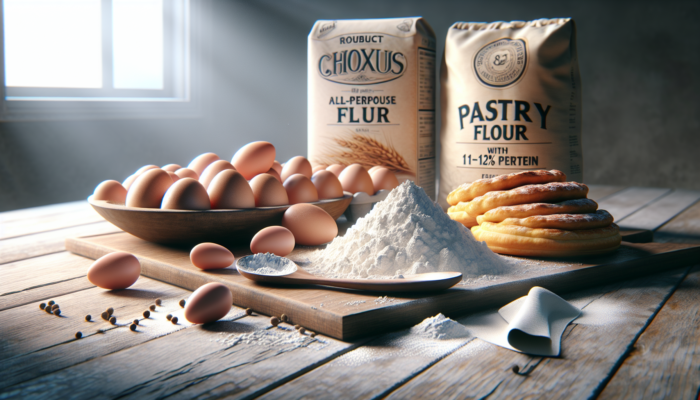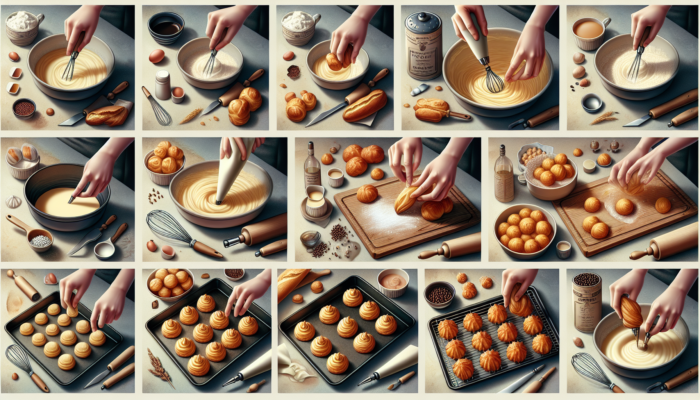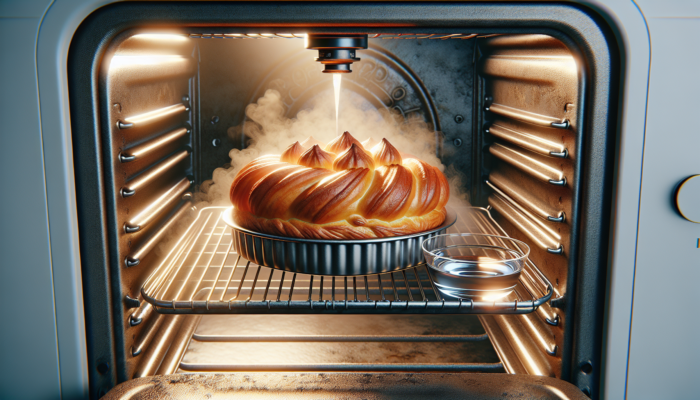Master the Art of Choux Pastry: Essential Techniques for Perfect Results
To achieve mastery in the craft of choux pastry, one must explore key strategies that lead to exceptional results. A deep understanding of the optimal ingredients, accurate ratios, and effective temperature management is vital. These foundational elements are essential to create that sought-after light and airy texture that makes choux pastry so delightful and irresistible, fulfilling the expectations of any pastry lover.
Selecting High-Quality Ingredients for Outstanding Choux Pastry

The success of any exceptional choux pastry is closely linked to the quality of its ingredients. The core component of this exquisite pastry is the flour. It's best to choose a strong all-purpose flour or, if available, a specialized pastry flour with a protein content of 11-12%. This perfect balance provides the necessary structure while ensuring a light, delicate crumb. Avoid using cake flour, as its lower protein content can result in a dough that lacks the strength required to maintain its shape during baking.
In addition, the choice of butter plays a significant role in the flavor of your choux. Opt for unsalted butter to maintain better control over the saltiness of your pastry. Always ensure that the butter is fresh and of superior quality; premium brands often have a higher fat content, which greatly enhances the overall taste and texture of your pastry.
Lastly, eggs are crucial for the creation of perfect choux. Large eggs are typically the ideal choice, as they provide essential moisture and structural support. The method of incorporating eggs into your dough is vital; begin by whisking them in a bowl, then slowly add them to your cooked flour and butter mixture. This gradual incorporation is key to achieving a smooth and glossy consistency, which is perfect for piping.
Achieving the Perfect Ingredient Ratios for Flawless Choux Pastry Consistency
Mastering the ratios of your ingredients is essential for obtaining the perfect choux pastry consistency. The traditional ratio for crafting choux pastry typically adheres to the formula of 1:1:2:2—one part flour, one part butter, two parts water, and two eggs. This straightforward yet effective formula guarantees the ideal rise and texture that pastry enthusiasts seek.
For example, if you start with 100 grams of flour, you should use the same amount of butter (100 grams) and double the water quantity (200 grams). This careful balance ensures that your pastry rises beautifully and retains its shape after baking, creating the perfect treat for any occasion.
However, it's essential to recognize that these ratios may need slight adjustments based on the humidity and temperature conditions in your kitchen. If the environment is particularly warm, you might need to decrease the water or eggs slightly to avoid a loose dough. Conversely, in cooler settings, you may need to add a bit more liquid. Trust your instincts and closely monitor the consistency of the dough as you mix to achieve optimal results.
Mastering Temperature Control for Mixing and Baking Choux Pastry
Effective temperature control is critical during both the mixing and baking stages of choux pastry. When cooking the flour and butter mixture, it’s essential to do so over medium heat. This technique allows the butter to melt thoroughly and the flour to cook without browning. The mixture should form a cohesive ball that pulls away from the sides of the pan, indicating that it is ready for the subsequent steps.
After cooking the mixture, allow it to cool slightly before adding the eggs. If the mixture is too hot, it can inadvertently cook the eggs, resulting in a lumpy texture that is undesirable. Conversely, if the mixture is too cool, the dough may not rise adequately in the oven. A good rule of thumb is to cool the mixture to approximately body temperature before incorporating the eggs, ensuring a smooth and consistent dough.
Maintaining a consistent temperature throughout the baking process is also essential for success. Preheat your oven thoroughly and avoid opening the door during the first half of the baking time, as this can lead to collapsing pastries. For optimal results, the ideal baking temperature for choux pastry is around 200°C (390°F). This high heat is crucial for transforming the water in the dough into steam, which creates the light and airy texture that characterizes well-crafted choux pastry.
Step-by-Step Guide to Creating Exceptional Choux Pastry

Having explored the essential strategies, let's delve into a comprehensive, step-by-step guide that will empower you to create your own stunning choux pastry masterpiece. By diligently following these detailed instructions, you'll be well-prepared to produce perfect choux every single time, impressing your family and friends alike.
Essential Techniques for Preparing Choux Pastry Dough with Accuracy
Creating choux pastry dough may seem straightforward, but it requires careful attention to detail. Begin by accurately measuring your ingredients. In a medium saucepan, combine water, butter, and salt. Bring this mixture to a gentle boil over medium heat, ensuring that the butter melts completely and is fully incorporated.
Once it reaches a boil, promptly remove the pan from the heat source and immediately mix in the flour. Stir vigorously with a wooden spoon or spatula until the mixture forms a cohesive ball that pulls away from the edges of the pan. This step is crucial, as it allows the flour to cook and develop the necessary structure for your pastry, ensuring it rises beautifully.
Next, transfer the dough to a mixing bowl and let it cool for approximately five minutes. This cooling period is vital to prevent the eggs from cooking upon contact, which could ruin the texture. Gradually add the eggs, mixing thoroughly until the dough is smooth and glossy. The dough should fall from the spatula in a thick ribbon; if it feels too stiff, add a little more egg; if it’s too runny, you may need to incorporate more flour to balance it out.
Once your dough achieves the desired consistency, allow it to rest for at least 15 minutes. This resting phase is essential for relaxing the gluten, which results in a more tender pastry that is easier to pipe and shape into the forms you desire.
Refining Your Piping Techniques for Perfectly Shaped Choux Pastry
Piping choux pastry is an intricate art that can dramatically influence the shape and uniformity of your pastries. Start by preparing your piping bag fitted with a round tip—typically, a 1cm (0.4 inches) plain tip works best for both éclairs and cream puffs, ensuring consistent results.
Fill your piping bag with the prepared pastry dough. To achieve uniform shapes, pipe the dough onto a lined baking sheet while holding the bag at a 90-degree angle. Gently squeeze the bag while lifting it to create a peak, then stop applying pressure before pulling away to avoid leaving unsightly tails behind.
For éclairs, pipe straight lines measuring about 10cm (4 inches) long, and for cream puffs, create small mounds approximately 4cm (1.5 inches) in diameter. To achieve a smooth finish, lightly dip your fingertip in water and gently smooth down any peaks left from piping. This small step will help create an elegant appearance once baked, enhancing the visual appeal of your finished pastries.
Ensure there is ample space between the pastries on the baking tray, as they will expand during baking. Maintaining at least 5cm (2 inches) of space between each piped piece is a good guideline to follow, allowing for optimal puffing without merging into one another.
Critical Baking Tips for Creating Perfectly Fluffed Choux Pastry

Baking is where the true magic happens for choux pastry. To ensure even rising and thorough cooking, preheat your oven to 200°C (390°F) and position your baking tray in the center of the oven for optimal heat distribution.
To create steam, which is vital for the rise of the pastry, place a small oven-safe dish filled with water at the bottom of your oven. This will generate a humid environment that prevents the pastries from drying out too quickly and helps them achieve that perfect puff, resulting in a light and airy texture.
Avoid opening the oven door during the first 20 minutes of baking. A sudden drop in temperature can cause your pastries to collapse, leading to flat and disappointing results. After 20 minutes, you can briefly check on their progress. If they are rising nicely and developing a beautiful golden brown color, you are on the right track for a successful bake.
When the pastries are fully baked, they should be golden on top and firm to the touch. Remove them from the oven and allow them to cool on a wire rack. This cooling phase is essential to prevent sogginess; if left on the baking tray, moisture can accumulate and negatively impact the texture of your delightful pastries.
Effective Solutions for Common Choux Pastry Challenges
Even seasoned bakers may encounter challenges while crafting choux pastry. Being able to identify these common issues and their solutions is essential for mastering the secrets to achieving flawless choux pastry creations.
Diagnosing and Fixing Flat Pastries: Primary Causes and Solutions
Flat choux pastries can result from several factors. A primary cause is insufficient steam during the baking process. If your dough lacks moisture or the oven environment is too dry, the pastries may not rise as anticipated. To remedy this, ensure that your water-to-flour ratio is precise, and consider adding extra egg for added moisture, which helps achieve that perfect puff.
Improper mixing can also lead to flat pastries. If the dough isn’t mixed thoroughly after incorporating the eggs, it may become too dense, obstructing the necessary lift. Mix until the dough is smooth and glossy to facilitate that light, airy texture that is characteristic of well-made choux pastry.
Moreover, avoid opening the oven door prematurely. A sudden temperature drop can lead to collapsing pastries. Exercise patience and wait until they have risen adequately before checking on them, ensuring consistent heat throughout the baking process.
Preventing Soggy Bottoms in Your Choux Pastry Creations
Soggy bottoms can be a frustrating issue when baking choux. This problem often arises from either underbaking or excess moisture in the dough. To prevent soggy bottoms, ensure your pastries are baked until they achieve a golden brown color and feel firm to the touch, indicating they are done.
Using a baking sheet lined with parchment paper can also assist in absorbing moisture, ensuring a crisp finish. If you discover that your pastries remain soggy, consider returning them to the oven for additional baking time to ensure they dry out completely, achieving the perfect texture.
Another practical tip is to pierce the bottom of the pastries with a toothpick after baking, allowing steam to escape. This technique helps prevent moisture from being trapped inside, resulting in a crispier finish that enhances the overall quality of your pastries.
Resolving Cracking Issues During the Baking Process
Cracking in choux pastry is a common issue caused by various factors. One primary reason for cracking is baking the pastries at excessively high temperatures. While a high initial temperature is vital for rising, the pastry may rise too rapidly and develop cracks if the temperature is too high.
To address this, consider reducing the temperature slightly after the first 15 minutes of baking, allowing for a more gradual rise that minimizes cracking and ensures a smooth finish.
Overmixing the dough after adding the eggs can also lead to a fragile structure that struggles to support the rising process. Mix just until the ingredients are combined and smooth for the best results, promoting a stable and well-structured choux pastry.
Lastly, ensure that you are using fresh ingredients. Old flour or stale eggs can negatively impact the quality of your pastry, leading to unsatisfactory outcomes that can be avoided with careful ingredient selection.
Exploring Advanced Techniques to Elevate Your Choux Pastry Skills
Once you have mastered the fundamentals, it’s time to explore advanced techniques that will elevate your choux pastry creations to extraordinary heights, allowing for creativity and innovation in your baking endeavors.
Crafting Choux Au Craquelin: A Textural and Flavorful Enhancement
Choux au craquelin is a delightful variation on traditional choux pastry. It features a crunchy topping that adds delightful texture and enhanced flavor. To prepare this variation, create a simple sugar cookie dough using equal parts flour, butter, and brown sugar, mixing until just combined for the perfect consistency.
Roll the craquelin dough into a thin sheet and cut it into smaller circles than your piped choux. Before baking, place a circle atop each piped pastry. As the pastries rise, the craquelin spreads, forming a delightful, crunchy topping that beautifully contrasts with the soft interior of the pastry below, creating a delightful eating experience.
This technique not only adds visual appeal but also enriches the overall flavor profile of your choux creations, making them even more enticing for those who savor the art of pastry.
Infusing Unique and Exciting Flavors into Your Choux Pastry
Infusing flavors into your choux pastry dough can lead to exciting and innovative creations that surprise and delight. Consider infusing your butter with vanilla, citrus zest, or spices like cinnamon before mixing it with the flour. Such subtle enhancements can elevate your pastries, making them truly unique and memorable for anyone who enjoys a flavorful treat.
Another exciting option is directly incorporating extracts or flavorings into the dough. For example, adding a touch of almond extract can provide a delightful twist to classic éclairs. Be cautious with the amounts used, as a little can go a long way in flavoring, ensuring a balanced taste.
For a more adventurous approach, consider adding cocoa powder to your flour to create chocolate choux pastry. This rich base pairs beautifully with fillings like cream or custard, resulting in an indulgent treat that satisfies chocolate lovers and pastry enthusiasts alike.
Perfecting the Art of Filling and Decorating Choux Pastry
The final step in perfecting your choux pastry involves mastering the art of decorating and filling. Classic fillings such as whipped cream, pastry cream, or custard are always popular choices for enhancing flavor and texture. To fill your pastries, use a piping bag fitted with a small round tip. Insert the tip into the base of the pastry and gently squeeze until you feel slight resistance, ensuring a generous filling.
For decoration, consider glazing your éclairs with a simple chocolate ganache or icing to create a beautiful finish. A light dusting of powdered sugar on cream puffs adds an elegant touch that elevates the presentation. You might also experiment with edible gold leaf or colorful sprinkles for a festive flair that impresses your guests.
Remember, presentation is key to making a lasting impression. Take the time to arrange your pastries artfully on a plate, and consider pairing them with fresh fruit or a berry coulis for an added splash of color and flavor contrast, creating a delightful culinary experience.
Real-World Applications of Choux Pastry: Versatile Culinary Uses
Understanding the diverse applications of choux pastry can unlock a world of culinary possibilities. Here are some classic and modern uses of choux pastry that showcase its versatility, appealing to a wide range of tastes.
Creating Classic Éclairs and Profiteroles with Flair
Éclairs and profiteroles are among the most recognized forms of choux pastry. Éclairs are long, filled pastries traditionally filled with pastry cream and topped with chocolate icing. To create perfect éclairs, pipe elongated shapes onto a baking sheet. Once baked and cooled, fill them with your preferred filling and drizzle with chocolate ganache for a classic finish that delights the senses and adds a touch of elegance.
Conversely, profiteroles are small, round puffs often filled with whipped cream or ice cream. They can be served plain or drizzled with chocolate sauce for a delicious dessert experience. To create profiteroles, pipe small rounds and bake just as you would for éclairs. Once filled, they can be beautifully assembled into a croquembouche, creating an impressive centerpiece for any occasion that is sure to impress your guests.
Transforming Choux Pastry into Delectable Churros and Beignets
Choux pastry can also be adapted to create popular fried treats such as churros and beignets. For churros, pipe the dough into hot oil and fry until they achieve a golden brown hue, creating a crispy exterior and a soft interior. After frying, toss them in cinnamon sugar for a delightful treat that is crispy on the outside and soft on the inside.
Beignets, the iconic French doughnuts, can similarly be made using choux pastry. Pipe small dough balls into hot oil and fry until they puff up and turn golden. Dust them with powdered sugar for an indulgent dessert that is sure to impress, providing a delightful experience for anyone who enjoys these classic pastries.
Exploring Savory Applications of Choux Pastry for Unique Dishes
Choux pastry isn't limited to sweet treats; it can also be utilized to create a variety of savory dishes. Cheese puffs, or gougères, are a fantastic example of this versatility. By adding grated cheese, such as Gruyère or cheddar, to your choux pastry dough before piping and baking, you can create delightful appetizers or party snacks that are sure to please.
These cheesy delights are perfect for entertaining or as a tasty addition to any meal. You can also experiment by incorporating herbs or spices into the dough, making them versatile options that can complement a wide range of flavors and culinary styles, appealing to both savory and sweet lovers alike.
Insights from Experts on Mastering Choux Pastry: Knowledge from the Professionals
Gaining insights from professional pastry chefs can provide invaluable guidance in perfecting your choux pastry skills. Here are expert tips and common pitfalls to avoid along the way, ensuring a smooth baking journey.
Crucial Advice from Professional Pastry Chefs
Many professional pastry chefs emphasize the importance of practice in mastering choux. Renowned chefs recommend starting with small batches to refine your technique before progressing to larger quantities. They also stress the necessity of patience; choux pastry can be unforgiving, and it may take several attempts to achieve that perfect puff, so don’t be discouraged by initial setbacks.
Another crucial piece of advice is to trust your instincts regarding ingredient ratios. While standard recipes serve as valuable guidelines, slight modifications may be necessary depending on environmental factors, such as humidity or altitude, that may influence your dough's performance.
Avoiding Common Errors in Choux Pastry Preparation
One of the most prevalent mistakes is underestimating the importance of high-quality ingredients. Always choose fresh, top-quality components to ensure the best results in your baking endeavors. Additionally, many bakers tend to rush through the mixing process. Taking your time and ensuring the dough is well combined is essential for achieving optimal texture, so don’t skip this crucial step.
Another frequent error is neglecting to allow the pastry to cool adequately before filling. This oversight can result in a soggy filling and an unsatisfactory texture. Always ensure that your choux pastry is completely cool before adding any fillings to maintain the best quality and prevent unwanted moisture.
Exploring Innovative Trends in Choux Pastry Creation
The choux pastry landscape is continuously evolving, with innovative trends emerging regularly. There is a growing interest in health-conscious adaptations, including gluten-free or vegan choux pastry options. Many chefs are experimenting with alternative flours and egg substitutes, ensuring that everyone can savor these delightful pastries without dietary restrictions.
Additionally, flavor fusion is on the rise, with bakers incorporating unique combinations and global influences into their choux creations. From matcha éclairs to spiced profiteroles, the possibilities are virtually limitless, allowing for creativity and innovation in the kitchen that delights both traditionalists and modernists alike.
Frequently Asked Questions About Choux Pastry: Addressing Your Concerns
Can Choux Pastry Be Frozen for Future Use?
Yes, you can freeze choux pastry. Simply pipe the dough onto a baking sheet and freeze until solid. Once frozen, transfer the pastry to a zip-top bag and store it for up to three months. When you're ready to bake, proceed directly from frozen, adding a few extra minutes to the baking time for optimal results, ensuring that your pastries are just as delightful as fresh.
How Long Can Choux Pastry Be Safely Stored?
Choux pastry is best enjoyed fresh but can be stored in an airtight container for up to two days. To preserve optimal texture and flavor, it is advisable to consume filled pastries within a few hours of preparation, as they are at their best when freshly made.
Is It Possible to Create Gluten-Free Choux Pastry?
Absolutely! You can substitute regular flour with a gluten-free all-purpose blend. Just ensure that the blend contains xanthan gum for the best structure and texture in your pastries. You may also need to adjust the liquid content, as gluten-free flours can absorb moisture differently compared to traditional flour, ensuring that your dough maintains the right consistency.
What Causes My Choux Pastry to Collapse While Baking?
Choux pastry may collapse due to underbaking, which prevents it from setting properly. Always bake until the pastries are golden brown, and avoid opening the oven door too early to maintain consistent heat throughout the baking process, which is crucial for achieving that perfect puff.
Can I Use Oil Instead of Butter in Choux Pastry Preparation?
While butter is essential for flavor and texture, you can use a neutral oil as a substitute. However, this may alter the overall taste and richness of the pastry, so it is generally recommended to stick with butter for the best results and to ensure a delicious outcome.
How Can I Achieve a Crispier Texture in My Choux Pastry?
To create a crispier choux pastry, ensure proper baking time and temperature. You can also pierce the pastries after baking to allow steam to escape, which prevents sogginess and enhances the final texture, resulting in a delightful crunch.
What Are Popular Fillings for Choux Pastry Creations?
Typical fillings for choux pastry include whipped cream, pastry cream, custard, and ice cream. For savory alternatives, consider using cheese, herbed cream cheese, or savory custards that add depth and flavor, providing a delightful contrast to the pastry.
Can I Prepare Choux Pastry Dough Ahead of Time?
While choux pastry is best baked fresh, you can prepare the dough in advance and refrigerate it for up to a day. Remember to let it reach room temperature before piping and baking to ensure optimal results and achieve the desired texture.
What's the Best Method for Storing Filled Choux Pastry?
Filled choux pastries can be stored in an airtight container in the refrigerator for up to two days. It is advisable to fill them just before serving to maintain the best texture and flavor, ensuring a delightful experience for your guests.
How Do I Know When My Choux Pastry Is Done Baking?
Choux pastry is fully baked when it is golden brown and firm to the touch. Additionally, it should sound hollow when lightly tapped on the bottom, indicating that it has cooked through properly, ensuring a delightful pastry experience.
Join us on Facebook for the latest updates and tips!
The post Choux Pastry Secrets: Master the Art Flawlessly appeared first on https://cookinggods.com
The Article Choux Pastry Secrets: Flawlessly Master the Art Was Found On https://limitsofstrategy.com



I appreciate the focus on ingredient quality in your post. When I first attempted choux pastry, I underestimated how significant the flour choice could be. Swapping out my usual all-purpose flour for a higher-protein pastry flour truly changed the game—it allowed my éclairs to rise beautifully and have that perfect texture.
It’s great to hear how your experience with flour made such a difference. Choosing the right type can really transform a recipe like choux pastry. The protein content in higher-protein pastry flour can definitely contribute to that perfect rise and structure. Have you experimented with any other flour types? Sometimes blending a bit of cake flour into the mix can add a lovely delicacy to the texture, too. And it’s always fascinating how small adjustments can lead to significant improvements in our baking adventures. What else have you tried since your initial choux pastry experience?
I’m so glad to hear that you had great success with your flour choice! If you’re looking to explore more tips on perfecting your choux pastry and choosing the best ingredients, check out this helpful resource!
https://blognetwork.co.uk/emailoctopus
It’s interesting how much of a role flour plays in the final outcome, isn’t it? I’ve definitely dabbled with different types since making that choux pastry. Recently, I tried combining all-purpose flour with a bit of whole wheat flour. It gave the pastry an unexpected nutty flavor that worked surprisingly well for savory applications, like gougères. I’ve also moved into exploring different types of gluten-free flours, as I have some friends with dietary restrictions. Almond flour can be tricky due to its fat content, but it adds a lovely moisture when you get the ratios right.
It’s great to hear about your experiments with flour types, especially with choux pastry. Flour really does have such a transformative impact on the final product. The combination of all-purpose and whole wheat flour sounds intriguing. The nutty flavor must add a wonderful depth to gougères. There’s something special about how a small change, like tweaking the flour mix, can really elevate a dish, especially in savory pastries where you might not expect a bit of nuttiness to shine through.
“That’s such a great observation about the nuances of flour! If you’re looking to explore even more interesting flour combinations, check out this guide I put together—it dives into the world of different flours and their unique properties!”
https://blognetwork.co.uk/ChocolateHealth
I really resonate with your exploration of different flour types. Flour can definitely transform the character of a dish in subtle but impactful ways. Combining all-purpose with whole wheat for your choux pastry sounds like a smart move—those nutty undertones can really elevate the flavor profile in savory recipes like gougères.
I really appreciate the deep dive into choux pastry techniques! I’ve always found it fascinating how such a simple mixture can yield something so delightful when executed correctly. Your emphasis on ingredient quality resonates with me; I’ve definitely had my share of underwhelming attempts when I skimped on flour selection.
It’s wild how a simple mix of flour, water, butter, and eggs can turn into something that makes you feel like a pastry wizard, right? It’s like the choux pastry is just waiting for the right moment to puff up and say, “Surprise!” The struggle with ingredient quality is real; using the wrong flour can feel like you’ve accidentally brought a rubber chicken to a food fight.